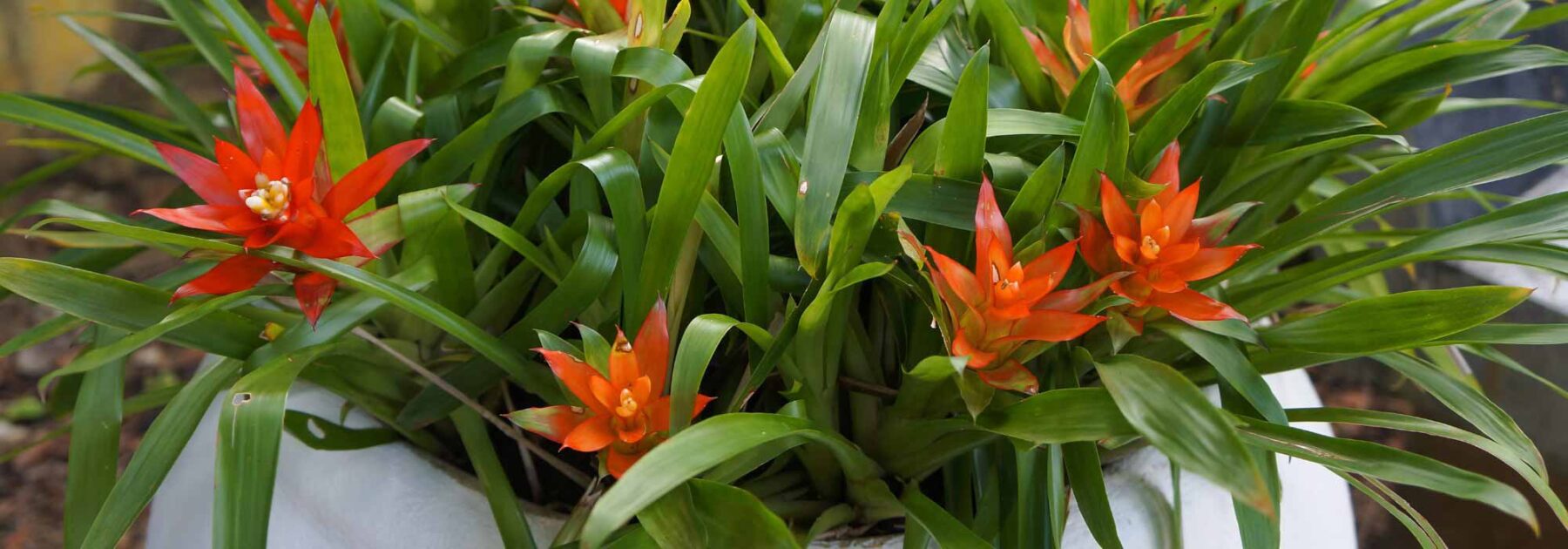
Guzmania: Care, Planting, and Tips
Contents
Guzmania in a Nutshell
- This is a perennial plant from the humid forests of Central and South America, perfectly suited for indoor cultivation.
- The Guzmania forms a rosette of ribbon-like, flexible, and glossy leaves.
- It offers a long flowering period consisting of colourful bracts, surrounding small, discreet flowers.
- It requires little care, and appreciates moderate watering and exposure to indirect light.
- Its minimally developed root system requires a light and well-drained soil to prevent water stagnation.
- It is ideal for warm and humid rooms such as bathrooms or bright conservatories.
A Word from Our Expert
The Guzmania is a remarkable tropical plant belonging to the Bromeliaceae family, cultivated in our climates as an indoor plant. It is cherished for its decorative foliage and its spectacular exotic flowering. Native to the moist forests of Central and South America, it adapts perfectly to indoor cultivation due to its moderate need for light and its ability to thrive in warm and humid environments.
With approximately 120 to 200 species, the Guzmania offers a great diversity of shapes and colours. Some species, like the Guzmania lingulata with its striking red bracts or the Guzmania conifera with orange conical inflorescences, are particularly valued for their unique aesthetic. Its rosette habit, colourful bracts, and air-purifying capabilities make it an ideal plant for creating a tropical ambiance in a bright living room, a humid bathroom, or a heated conservatory. Discover this vibrant plant that is so easy to maintain!
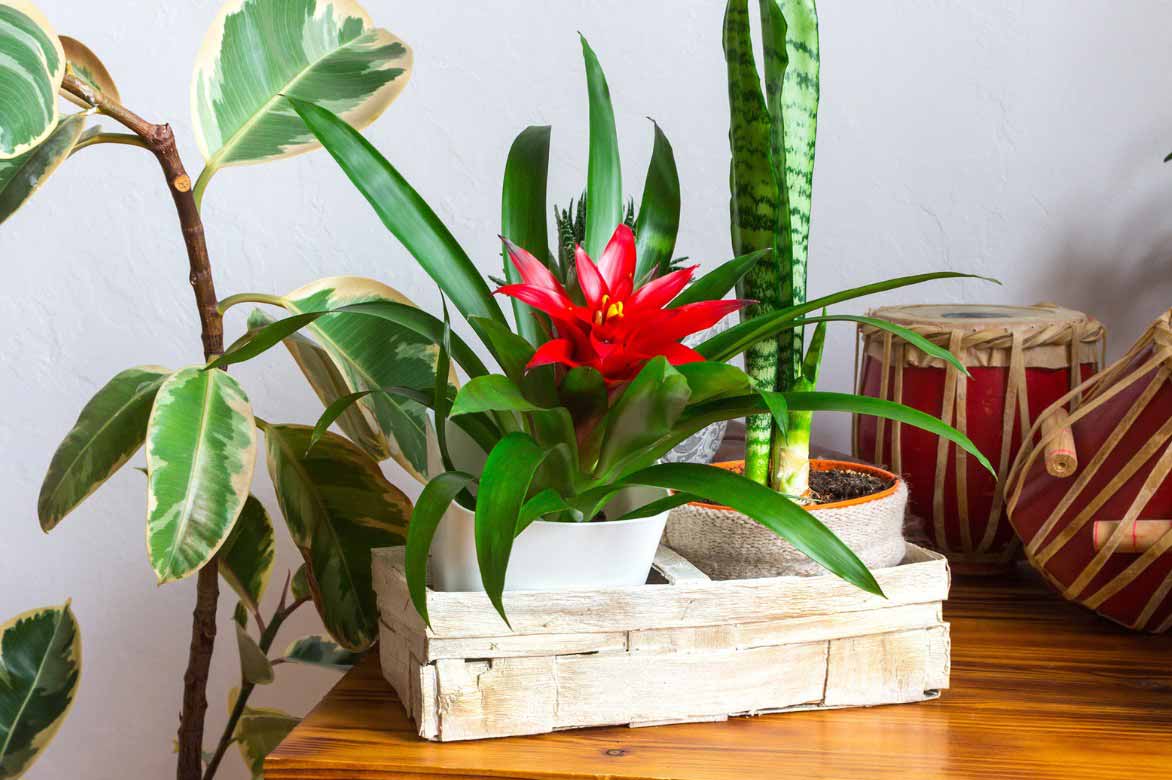
Botany and Description
Botanical data
- Latin name Guzmania
- Family Bromeliaceae
- Common name Guzmania, Guzman's Bromeliad
- Flowering From spring to summer
- Height Between 30 and 60 cm
- Sun exposure Bright light
- Soil type Light, draining, and airy substrate
- Hardiness Frost-sensitive
The Guzmania is a tropical plant from the Bromeliaceae family, also known as “Guzman’s Bromeliad”. The genus comprises about 120 species, characterized by their rosettes of leaves and their colorful inflorescences, often cone-shaped or in spikes, providing a brilliant display.
The Guzmania lingulata is arguably the most emblematic species of the Guzmania genus. Its specific name lingulata refers to the shape of its leaves, reminiscent of a tongue (lingua in Latin), elongated, flexible, and slightly arched. This plant captivates with its spectacular bracts, in vibrant hues ranging from bright red to orange, and shades of yellow and pink. Due to its popularity, the Guzmania lingulata has led to numerous cultivars with varied shapes and colors, specifically created to enrich indoor plant collections. Among them, we find:
- ‘Indian Night’: characterized by deep red bracts, almost burgundy, which bring a warm and elegant atmosphere.
- ‘Akabar’: notable for its bracts of an intense red, sometimes verging on scarlet, creating a striking contrast with its glossy green foliage.
- ‘Alerta’: with bright orange bracts, offering a luminous and vibrant touch, perfect for energizing an interior.
- ‘Calypso’: known for its golden yellow or orange tones, bringing a softer and more exotic note.
Also available in nurseries is the Guzmania conifera, recognizable by its conical inflorescence, very original, resembling a pine cone.
In its natural habitat, the Guzmania thrives in the humid tropical forests of Central and South America, ranging from Costa Rica to Ecuador and even in the Amazon. It is a perennial plant that generally grows as an epiphyte, clinging to tree branches, benefiting from filtered light and ambient moisture without ever parasitizing its host. This lifestyle allows it to flourish in the warm and humid environments typical of these areas.
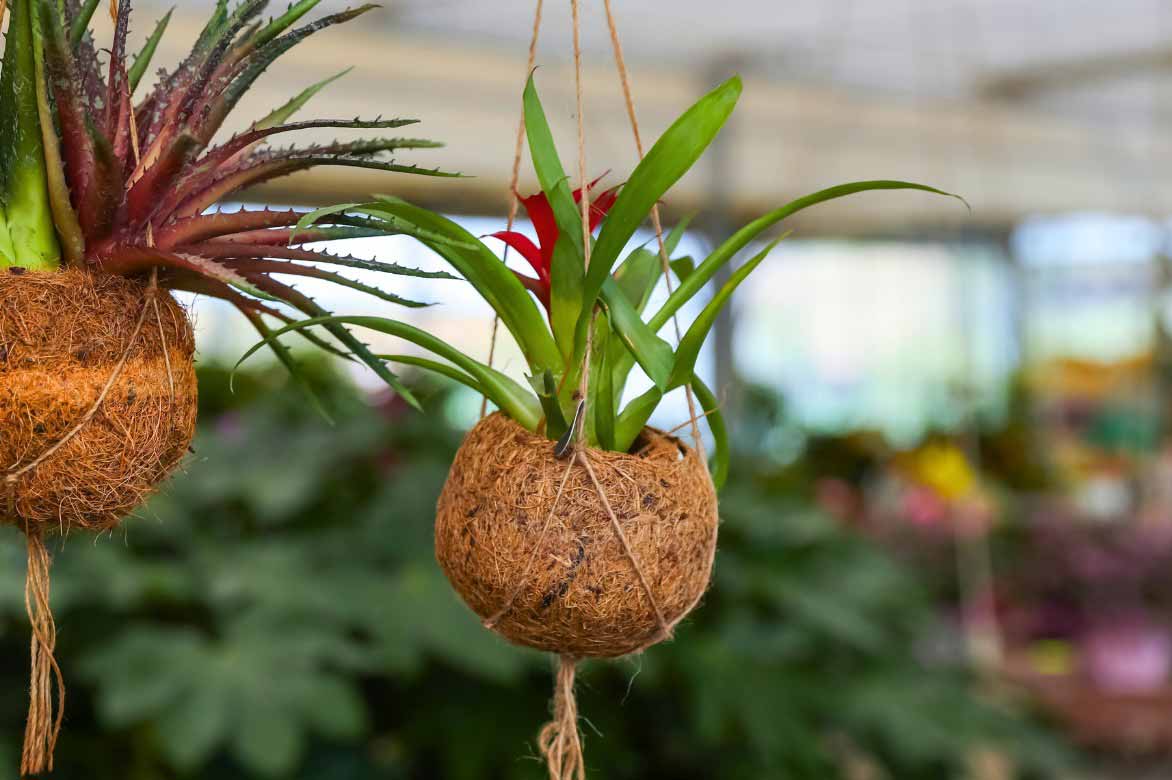
The Guzmania presents an elegant and exotic silhouette. Its habit is a compact rosette, formed by long, ribbon-like, and flexible leaves that spread harmoniously. This natural arrangement creates a sort of funnel at the center of the plant, called the central rosette, which serves to capture water and nutrients in its tropical environment.
Its root system is underdeveloped and shallow. The roots of the Guzmania primarily serve to anchor the plant to its support, especially when it grows as an epiphyte on trees in nature. They absorb few nutrients from the soil, which explains its need for a very light and well-drained substrate.
The foliage of the Guzmania is flexible, smooth, and glossy, with green leaves that can sometimes be slightly tinged with red or purple on the underside. These leaves can measure between 30 and 60 cm long depending on the species, and their tough texture helps to limit water evaporation.
The most spectacular element remains its inflorescence, often mistaken for a flower. This floral spike, about 30 cm high, consists of colorful bracts – red, yellow, orange, or pink – surrounding small, discreet flowers, tubular and ephemeral that last only 24 hours. This inflorescence emerges from the center of the rosette and can, in turn, last several months, adding a vivid and tropical touch. The Guzmania is a semelparous plant, meaning that it flowers only once before perishing. The mother plant lives between 3 and 4 years. However, in the meantime, it will have produced offshoots allowing it to naturally multiply.
The Guzmania, like many bromeliads, contributes to improving indoor air quality. Thanks to its rosette structure, it captures moisture and absorbs certain pollutants present in the air, thus helping to create a healthier environment. This ability to regulate humidity and filter toxins makes it an interesting indoor plant in confined spaces.
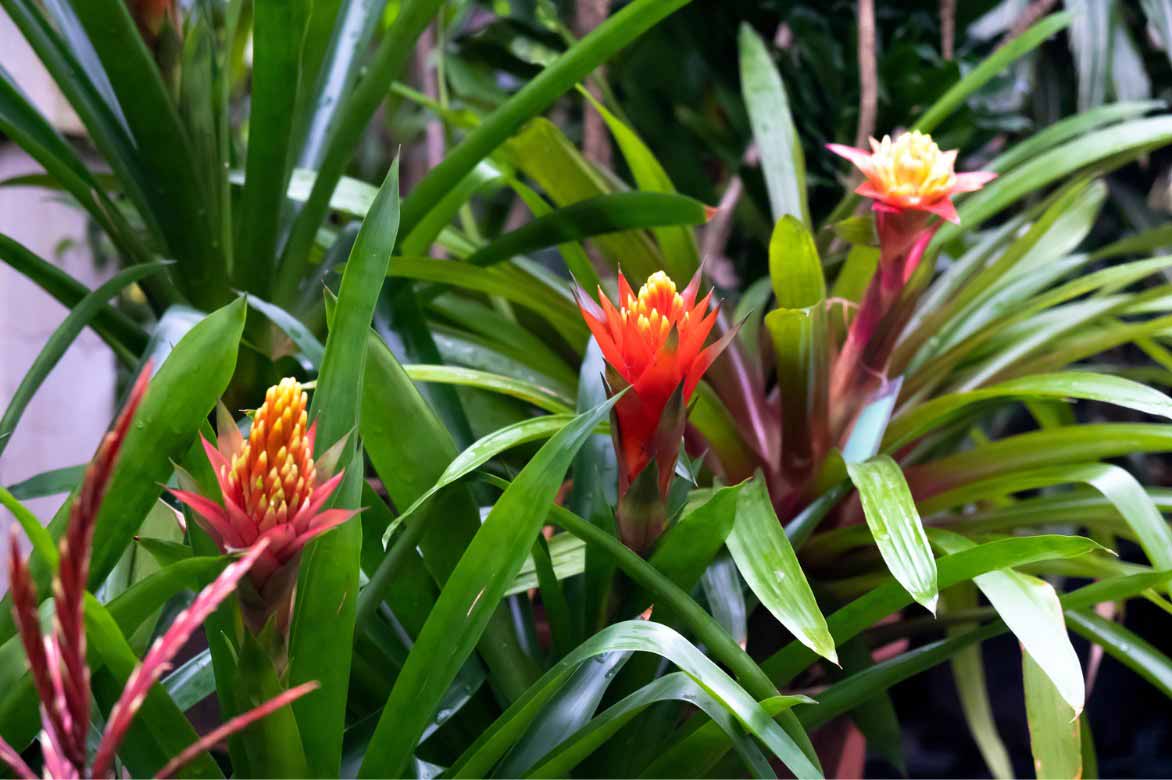
Main Species and Varieties
Guzmania Indian Night
Guzmania Akabar
Guzmania Alerta
Guzmania Calypso
Guzmania Filou
Guzmania Candy
Guzmania Flava
Guzmania Limones
Guzmania Loja
Guzmania Max
Guzmania Melissa
Indoor Planting of Guzmania
Where to Place Guzmania Indoors?
This tropical plant requires an environment where the temperature remains stable, ideally between 18°C and 25°C (never below 13°C) and with good ambient humidity to thrive fully. A bright corner, free from draughts and away from radiators, is a perfect spot to encourage its growth. Position it indoors or in a bright conservatory, as it enjoys warm and humid environments. Opt for a location with indirect or filtered light. Avoid direct sunlight which could scorch its leaves. A space with good ambient humidity, like a bright bathroom, is ideal.
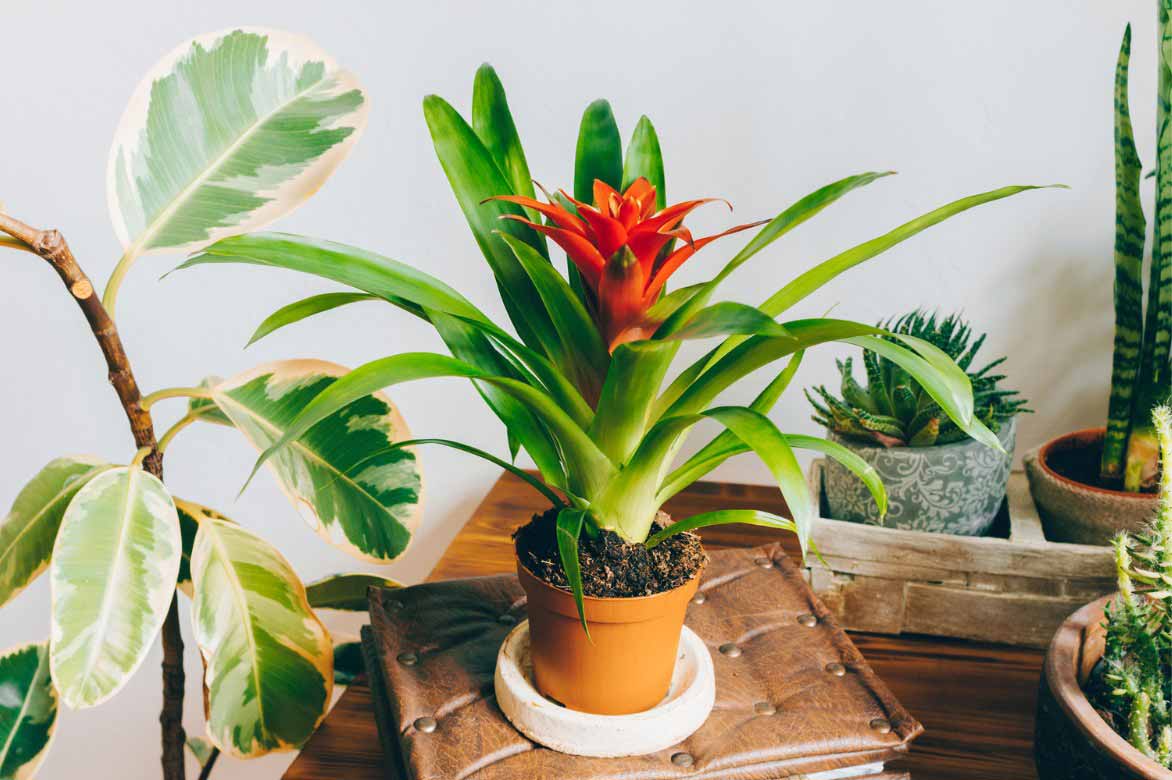
When to Plant Guzmania?
Guzmania can be planted, or more precisely repotted, all year round indoors, provided it is given suitable conditions. The environment must remain relatively warm (between 18°C and 25°C) and the air sufficiently humid. However, spring and early summer are the ideal times, as the plant is in an active growth phase, which facilitates its adaptation to a new pot or substrate. In autumn and winter, it will be necessary to compensate for the lack of light and avoid cold draughts.
How to Plant Guzmania?
- Choose a pot with drainage holes to ensure good drainage, as stagnant water can cause root rot.
- Fill the pot with a light and draining substrate, such as orchid compost or compost mixed with sphagnum moss and perlite.
- Gently place the plant in the center of the pot without burying the central rosette, as it needs to remain clear to capture water.
- Fill around the roots with the substrate, lightly pressing down to stabilize the plant.
- Water by pouring water directly into the central rosette, without soaking the compost.
- Maintain an ambient temperature between 18°C and 25°C to promote its growth.
- Regularly spray the leaves with non-limestone water to recreate its tropical environment.
How to Properly Care for a Guzmania?
Caring for Guzmania is straightforward and not very demanding, provided its needs related to its tropical origin are met. Watering should remain moderate: in summer, weekly watering is sufficient, while in winter, it can be reduced to every two weeks. The water, preferably non-limestone such as rainwater or filtered, should be poured directly into the central rosette, as this is the area through which the plant hydrates. It is important to regularly empty and refresh this water to prevent stagnation and reduce the risk of mould. The substrate should remain slightly moist without ever being waterlogged to prevent root rot. Never leave water in the saucer.
Guzmania does not require specific pruning. Simply remove wilted or damaged leaves at the base to keep the plant tidy and promote its growth. Once the flowering is over, the inflorescence can be cut close to the base to keep the plant looking attractive and prevent it from exhausting itself producing seeds.
This plant thrives in warm and humid environments, with an ideal temperature range between 18°C and 25°C. Regular humidity, especially through spraying non-limestone water on the leaves, is advisable, particularly in winter when indoor air is drier. It is also important to keep it away from draughts and direct heat sources like radiators.
It is also important to regularly dust the leaves of the Guzmania to maintain its health and lustre. Dust accumulation on the leaves can hinder photosynthesis and impair its ability to absorb ambient moisture. To clean the foliage, simply gently wipe with a damp cloth or a soft sponge.
During the growth period, from spring to summer, a monthly application of liquid fertilizer (orchid fertilizer) diluted directly in the rosette or during watering promotes its development. However, it is unnecessary to add fertilizer in autumn and winter, when the plant naturally slows down its growth.
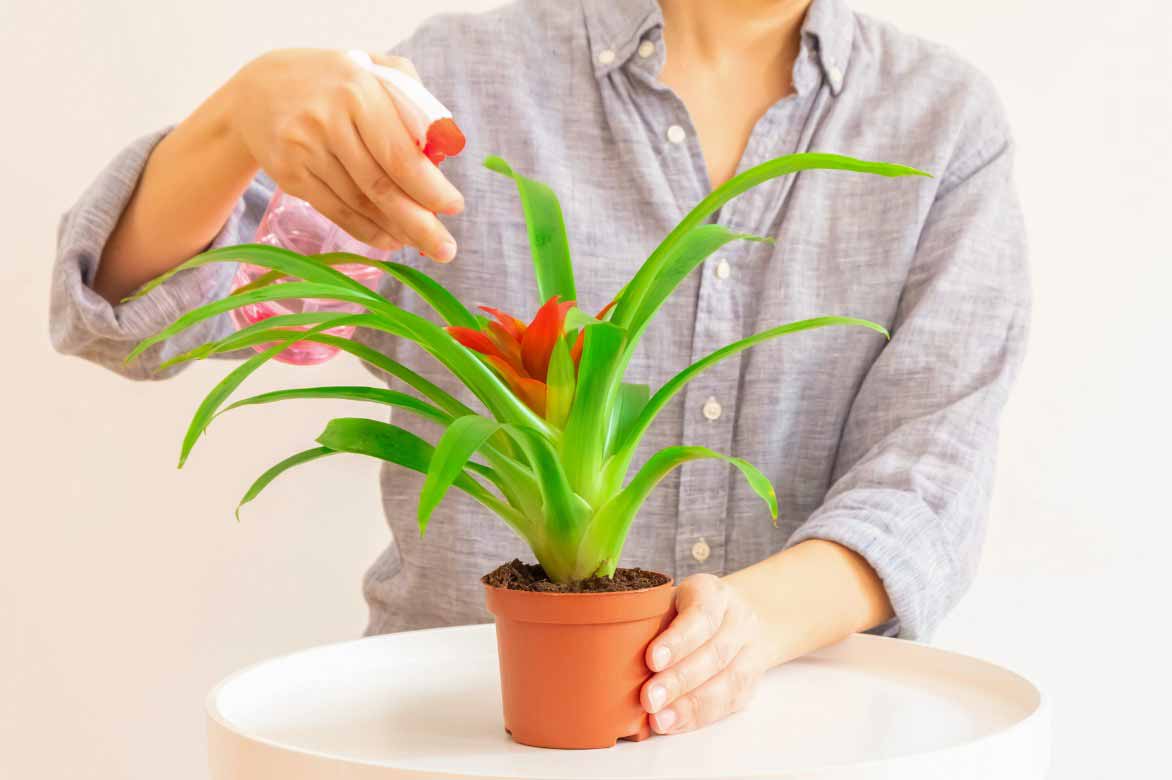
How to cut the faded flower of Guzmania?
Cutting the faded flower of Guzmania is recommended to extend the life of the mother plant. Once the flowering is over, the coloured bracts begin to dry out and gradually lose their brightness. It is then advisable to cut the floral stem as close to the base as possible, using a clean and sharp secateurs. This cut allows the plant to focus its energy on producing shoots, the young plants that will ensure its renewal. Leaving the faded flower in place can exhaust the plant, which will produce seeds, slow the appearance of these new shoots, and promote moisture accumulation in the rosette, thus increasing the risks of mould or rot. By removing the dead part, the plant is kept tidy and its life cycle is naturally extended.
Potential Diseases and Pests
Guzmania is generally a resilient plant, but it can sometimes be vulnerable to certain issues. **Excess moisture is one of its main enemies, leading to root rot or rotting of the central rosette, especially if water stagnates.** Poorly managed watering or inadequate drainage can promote fungal diseases. The plant may also suffer from brown spots on the leaves, often caused by burns due to direct sunlight exposure or by overly dry air.
As for pests, **Guzmania can attract** [**mealybugs**](https://www.promessedefleurs.com/conseil-plantes-jardin/ficheconseil/cochenille/ “mealybugs”), which nestle between the leaves and suck the sap, weakening the plant. **Aphids and [red spiders](https://www.promessedefleurs.com/conseil-plantes-jardin/ficheconseil/araignee-rouge-traitement/ “red spiders”) can also appear when the air is too dry**, causing yellowing or drying out of the foliage. To prevent these attacks, **it is important to maintain good ambient humidity** and to regularly monitor the plant to quickly detect any anomalies.
Propagation
After flowering, the Guzmania naturally produces shoots (small shoots) at the base of the mother plant. To propagate it, wait until these shoots are at least 10 to 15 cm tall and have some roots. With a bit of patience, they will become magnificent Guzmanias!
- Equip yourself with a clean, sharp knife or a disinfected secateurs to avoid any contamination.
- Gently remove the mother plant from the pot and detach the shoots by cutting them cleanly at the base. Be careful not to damage the young roots.
- Fill a small pot with a light, draining substrate, such as orchid compost or a mix of compost, sphagnum moss, and perlite.
- Plant the shoot without burying the central rosette.
- Lightly moisten the substrate and pour a little water into the central rosette. Be careful not to soak the soil.
- Wrap the shoot with its pot in a clear plastic bag to maintain a humid atmosphere and encourage rooting.
- Place the pot in a bright location, away from direct sunlight, with a temperature around 22 to 25°C (above a radiator, for example) and good ambient humidity.
- Regularly ventilate by opening the bag, water moderately, and frequently spray the leaves. The shoots will take a few weeks to root properly.
Useful Resources
- Explore our range of Bromeliads, these exotic young plants native to tropical regions!
- How to care for indoor young plants throughout the seasons?
- Our selection of books on indoor young plants
- Discover our range of green young plants and flowering indoor young plants to bring exoticism and elegance to your home.
- Subscribe!
- Contents
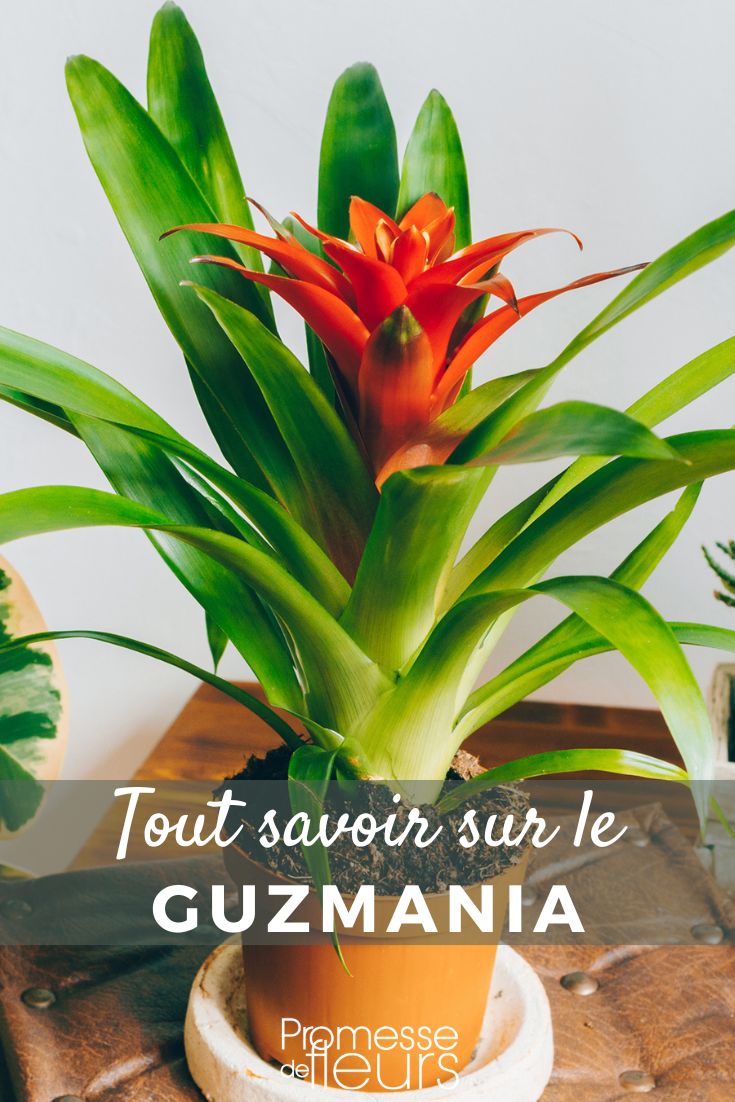


































Comments